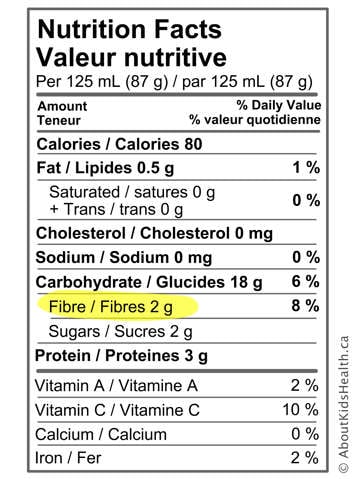What is fibre?
Fibre is a nutrient found in all plants. Unlike many other nutrients found in foods, fibre is not digested by the body. There are two types of fibre: soluble and insoluble. All foods that have fibre have some of each type.
Benefits of fibre
Insoluble fibre is good for the digestive system. It helps make your stool (poo) soft and bulky. This helps prevent constipation. Insoluble fibre is found in whole wheat products, corn bran and flax seeds. It is also in some vegetables and fruit.
Soluble fibre is good for the heart and blood circulation system. It may help lower blood cholesterol and help control blood sugar levels. Soluble fibre is found in fruits and vegetables. It is also in oat bran and oatmeal, barley, psyllium, and legumes.
Fibre can also help with weight control and helps in supporting a healthy gut microbiome.
When adding fibre to your diet, increase the amount slowly. It takes a little time for your body to get used to the extra fibre. It is also important to drink extra water when adding more fibre to your diet.
When choosing high-fibre foods, do not worry about the specific type of fibre. Many foods are high in both soluble and insoluble fibre. It is more important to eat a wide variety of high-fibre foods.
Recommended daily fibre by age group*
| Age and sex | Daily amount of fibre (grams) |
|---|---|
| 1 - 3 years | 19 g |
| 4 - 8 years | 25 g |
| 9 - 13 years Males Females |
31 g 26 g |
| 14 - 18 years Males Females |
38 g 26 g |
*These recommendations are presented here simply as a guide to help you make informed food choices.
What to look for on food labels

For fibre, food labels are marked like this:
- Source of Fibre: product with at least 2 g of fibre per serving.
- High Source of Fibre: product with at least 4 g of fibre per serving.
You can also look at the % Daily Value on the food label. If the % Daily Value is 5% or less, then the product contains only a little fibre. If the % Daily Value is greater than 15%, then the food contains a lot of fibre.
Sources of dietary fibre
Canada's Food Guide recommends eating plenty of fruits and vegetables, choosing whole grain foods, and including nuts, seeds, and legumes as sources of protein. Eating these foods regularly will also help provide a good amount of fibre in your diet.
Choose higher-fibre grains more often
| Lower-fibre choices | Higher-fibre choices |
|---|---|
| All white pasta; examples include macaroni, noodles, and spaghetti | Whole wheat pasta |
| Non-whole grain cereals; examples include Rice Krispies, Corn Flakes, Corn Pops, Froot Loops, and Special K | Whole grain cereals. Look for the words "bran," "whole," or "fibre" in the name of the cereal. |
| Non-whole grain cooked cereals; examples include Cream of Wheat | Whole grain cooked cereals; examples include oat bran, Red River, and oatmeal |
| All white breads. Examples include white bread, white or plain bagels, white bread sticks, dinner roll, Kaiser roll, English muffin, white hamburger or hot dog buns, white flour pita bread | Non-white breads. Examples include rye, whole wheat (look for the words "whole" or "stone ground"), multigrain, mixed grain, cracked wheat, whole wheat English muffins, hamburger and hot dog buns |
| Soda crackers | Rye crackers, graham crackers, Triscuits, whole wheat crackers |
| White rice | Brown rice, bulgur, barley, quinoa |
Choose higher-fibre fruits and vegetables more often
Fruits and vegetables are very important in all healthy diets. Generally, there are no fruits and vegetables that should be avoided, but try to include some higher-fibre choices everyday. Fruit and vegetable juices should be limited, since they have very little fibre.
Fruits
| Low-fibre choices | Medium-fibre choices | Higher-fibre choices |
|---|---|---|
Cherries Grapes Peaches Melons, including honeydew melons, cantaloupe, and watermelon Fruit juices and peeled fruits Fruit cocktails and sauces, such as apple sauce | Oranges and tangerines Peeled apples and pears Pineapples Bananas | Pears with skin Apples with skin Mangoes Blueberries Raspberries Strawberries Dried fruits, including peaches, prunes, apricots, figs, raisins, and cranberries |
Vegetables
| Low-fibre choices | Medium-fibre choices | Higher-fibre choices |
|---|---|---|
Onions Cucumbers Mushrooms Tomatoes Celery Cauliflower Cabbage Creamed corn Potatoes without the skin, such as peeled and mashed Asparagus Squash Lettuce Spinach | Bean sprouts String beans Broccoli Brussels sprouts Raw carrots Eggplant (aubergines) Parsnips Turnip Corn on the cob Whole kernel corn Potato with skin Sweet potato with skin | Green peas: fresh, frozen or canned Snow peas Swiss chard Legumes Popcorn (air-popped) |
Include legumes, nuts and seeds more often
Legumes and nuts are good sources of protein as well as good sources of fibre. Seeds can also provide fibre.
- Prepare meals that include legumes such as black beans, garbanzo beans, kidney beans, lentils and others to boost your fibre intake.
- One tablespoon of peanut butter has 2.7 grams of fibre. Spreading peanut butter thinly on a whole wheat cracker can help increase fibre.
- Nuts and seeds should not be offered to children under four years of age.
| Lower-fibre choices | Higher-fibre choices |
|---|---|
Coconut | Lentils Chickpeas Black beans Lima beans Kidney beans Soybeans Baked beans Nuts including almonds, pistachios, peanuts, and cashews Peanut and other nut butters |
Higher-fibre meal and snack ideas
Breakfast
- Your child's favourite cereal sprinkled with natural bran or bran flakes
- Whole wheat toast with thinly spread peanut butter
- Yogurt with berries and high-fibre granola
- Smoothie with ground flaxseed (see recipe below)
- Oatmeal
Lunch
- Sandwiches using whole wheat bread or bun. For example, try turkey, lettuce and tomato, or peanut butter and jam on whole wheat bread.
- Chili, minestrone soup, or black bean soup with whole wheat crackers.
- Whole wheat wrap with shredded chicken, sliced mango, and brown rice
- Quinoa salad with chickpeas, cucumber, and red pepper
Dinner
- Chicken fingers or fish sticks coated in wheat germ, bran cereal or whole wheat bread crumbs
- Whole wheat pasta with tomato sauce
- Lentil curry with whole wheat bread
- Salmon with brown rice and green beans
- Include sides such as cooked vegetables or a whole wheat dinner roll to boost the fibre in your meal
Snacks
- Bran or oat bran muffins
- Home-baked cookies with added wheat germ, wheat bran, nuts, or seeds
- Popcorn (for children over four years of age)
- Apple or pear slices with nut or soy butter
- Whole wheat pita bread with hummus
- Raw vegetables and dip
Serving Tips
To increase fibre intake:
- Use whole wheat flour with or instead of white flour.
- Add wheat bran to pancake, cookie, or muffin mixes.
- Use wheat germ, bran cereal, or whole wheat bread crumbs to coat chicken and fish.
- Add dried fruit to yogurt, hot and cold cereals, or even desserts like ice cream and pudding.
- Use whole wheat pasta and add extra high-fibre vegetables to tomato sauce.
- Make vegetable and bean soups. Try adding bulgur or barley instead of pasta.
- Add chopped nuts to salads.
- When cooking, add bran cereal or natural bran to stews and casseroles.
- Experiment with new higher-fibre foods; for example, chili made with kidney beans, nachos with re-fried beans, and black bean burritos.
- Snack on raw vegetables, fresh and dried fruits, or popcorn.
- Limit sugary, high-fat, and processed foods in your diet.
Remember
- Increase fibre content slowly to prevent bloating and gas.
- As you increase fibre in your diet, it is important to increase the amount of fluid you drink.
- Lack of exercise can lead to constipation. Make sure your child gets plenty of exercise.
- For all food suggestions, ensure textures are age-appropriate.
- For young children less than four years of age, avoid choking hazards such as whole nuts and seeds, and ensure fruits and vegetables are soft and cut into appropriate sizes. For example, cut grapes and cherry tomatoes in half or into quarters.
Raspberry-flax smoothie recipe
Fresh fruit smoothies are a great way to add more fibre in your diet. Adding flaxseed gives extra fibre. Try making this at home for breakfast. This recipe has 5 g of fibre per serving. Option: add other fruits, such as pear with the skin.
Mix in a blender and serve:
- 1/2 cup (125 ml) of milk
- 6 oz (175 g) plain vanilla yogurt
- 1/2 cup (125 ml) frozen raspberries
- 1 tablespoon (15 ml) flaxseed

